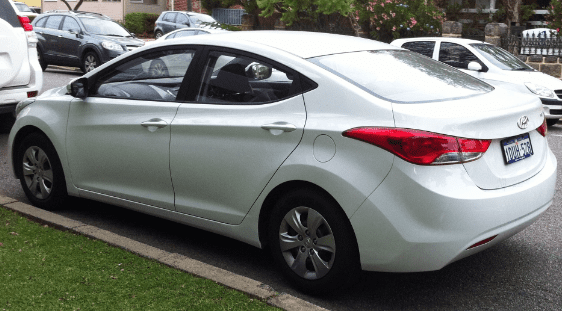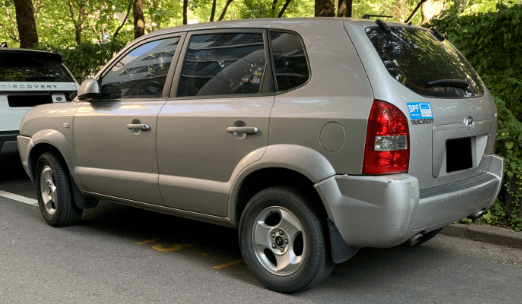[Top 5] Hyundai Elantra Transmission Problems & Solutions!
Last Updated on November 5, 2023 by Robert Wilson
Experiencing transmission problems in Hyundai Elantra vehicles can be highly vexing.
Numerous drivers have shared concerns about their Hyundai Elantras, including issues such as unusual noises and even complete transmission failure.
While some of these problems can be attributed to normal wear and tear, others may indicate a more serious issue that needs to be addressed.
Hyundai Elantra Transmission Problems and Solutions

| Transmission Problem | Possible Causes | Suggested Solutions |
|---|---|---|
| Transmission Slipping | – Low transmission fluid levels | – Check and refill transmission fluid at recommended intervals. – Address leaks causing low fluid levels. |
| – Worn clutch plates or bands | – Inspect and replace clutch components if needed. | |
| – Torque converter issues | – Repair or replace the torque converter as required. | |
| – Internal transmission damage | – Seek professional assistance for internal repairs. | |
| – Incorrect transmission fluid type | – Use the correct and recommended transmission fluid. | |
| Delayed Shifting | – Low or dirty transmission fluid | – Maintain proper fluid levels and quality. |
| – Worn clutch components | – Inspect and replace worn clutch parts. | |
| – Faulty solenoids | – Replace malfunctioning solenoids. | |
| Transmission Overheating | – Insufficient cooling | – Check cooling system and fluid levels. |
| – Overworking the transmission | – Drive with care and avoid excessive loads. | |
| Transmission Not Engaging Gears | – Faulty shift linkage or cable | – Inspect and repair the shift linkage. |
| – Damaged or worn transmission bands | – Replace or repair damaged bands. | |
| – Failing clutch or torque converter | – Address clutch or torque converter issues accordingly. |
Please note that these are general suggestions, and the exact solution for a specific problem may vary depending on the severity and the advice of a qualified mechanic.
Read More:
5 Hyundai Santa Cruz Issues (Solved)
8 Common Issues Hyundai Santa Fe
Huyndai Elantra problems Fix code [p0753]
Hyundai Elantra years to avoid
Here’s a table listing some Hyundai Elantra years that have had more reported issues, based on owner feedback and common problems:
| Year | Issues Reported |
|---|---|
| 2011 | Engine stalling, transmission |
| 2013 | Engine knocking, transmission |
| 2017 | Engine problems, transmission |
| 2020 | Brake issues, electrical |
Please note that this information is based on historical data and owner feedback.
Hyundai Elantra Transmission Recall
| Recall Date | Recall No. | Description |
|---|---|---|
| 00V332 | On certain passenger vehicles, the supplemental restraint system side air bag satellite sensors were improperly manufactured, causing the air bag warning light to illuminate and the side air bags to not deploy as intended in the event of a crash. Non-deployment of the side air bags could increase the risk of injury during a crash. | |
| 00V259 | Certain Sonata vehicles equipped with 2.5 liter V-6 engines and all Elantra vehicles may experience intermittent low-speed engine stalling, which occurs if the MAF (Mass Air Flow) Sensor electrical signal is interrupted as a result of engine vibration transmitted to the MAF Sensor connector wiring harness. This condition can increase the risk of a crash. | |
| 97V026000 | The windshield wiper motor circuit breaker electrical contacts were contaminated during assembly. | |
| 99V178 | Passenger vehicles equipped with automatic transmissions. The automatic transmission pressure control solenoid valve seals can allow transmission fluid to leak. This leakage can result in reduced pressure application to the clutches, brake, and kickdown servo, allowing them to slip. This slippage causes the vehicle not to accelerate, or not accelerate as expected, when the driver presses the accelerator pedal. | |
| 03V257 | On certain passenger cars and sport utility vehicles, the rear brake tubes pass behind the front suspension crossmember. Two steering gearbox mounting brackets are welded to the crossmember. On vehicles equipped with an antilock brake system (ABS), the rear brake tubes could contact both steering gearbox mounting brackets. On vehicles that are not equipped with ABS, the rear brake tubes may contact only the left mounting bracket. Contact between the rear brake tubes and the steering brackets could cause wear and corrosion that could result in brake fluid leakage. Fluid leakage could result in reduced braking capability, increasing the risk of a crash. | |
| 04V178 | Some passenger vehicles contain a fuel tank assembly valve that may not close properly. If a vehicle with a fuel tank assembly valve that is not properly closed were to roll over, fuel may spill. Spilled fuel in the presence of an ignition source may result in a fire. | |
| 23V526000 | Hyundai Motor America (Hyundai) is recalling certain 2023-2024 Palisade Tucson, 2023 Sonata, Elantra, and Kona vehicles. The electronic controller for the Idle Stop & Go oil pump assembly may contain damaged electrical components that can cause the pump controller to overheat. | |
| 22V632000 | Hyundai Motor America (Hyundai) is recalling certain 2022 Elantra N and 2022-2023 Elantra vehicles. The emblem on the cover of the driver’s front air bag may not have been welded properly, which can result in the emblem detaching upon deployment. | |
| 22V354000 | Hyundai Motor America (Hyundai) is recalling certain 2020-2022 Accent, 2021-2022 Elantra, and 2021-2022 Elantra HEV vehicles. In the event of a crash, the front driver-side and/or passenger-side seat belt pretensioners may explode upon deployment. | |
| 22V218000 | Hyundai Motor America (Hyundai) is recalling certain 2021-2022 Elantra and 2020 Accent vehicles. In the event of a crash, the front driver and passenger-side seat belt pretensioners may explode upon deployment. |
Please note that this table provides information on various recalls related to Hyundai vehicles, including the Hyundai Elantra.
Read More:
[Top 7 Fixes] Hyundai Palisade Problems
6 Common Hyundai Veloster Problems
The company has issued a recall for certain model years of the Elantra due to an issue with the transmission shifter assembly. This can cause the car to suddenly shift into neutral while driving, which obviously presents a safety hazard.
If you have an affected vehicle, take it to a Hyundai dealer to have the shifter assembly replaced free of charge.
In the meantime, be careful when driving your Elantra and keep an eye on the transmission shift indicator to make sure it doesn’t unexpectedly move into neutral!
Hyundai Elantra Pros and Cons
The Hyundai Elantra, like any car, has its pros and cons. Let’s explore some of the advantages and disadvantages of the Hyundai Elantra:
Pros:
- Affordability: The Hyundai Elantra is known for its competitive pricing, providing a lot of value for the money. It’s often considered an affordable option for budget-conscious buyers.
- Fuel Efficiency: Elantra models typically offer impressive fuel efficiency, making it a cost-effective choice for those looking to save on gas expenses.
- Handling: The Elantra offers excellent handling, with responsive steering and a comfortable ride. Many auto reviewers praise its overall performance and drivability.
- Stylish Design: The Elantra has a modern and distinctive aesthetic with sleek lines and eye-catching exterior features. It stands out among other compact sedans due to its stylish design.
- Safety Features: Hyundai has equipped the Elantra with a range of safety features, which may include options like adaptive cruise control, lane-keeping assist, and automatic emergency braking.
Cons:
- Inconsistent Interior Materials: Some Elantra models may have inconsistent interior materials, leading to a perception of lower quality in certain areas of the cabin.
- Refinement of 2.0L Engine: The base 2.0L engine in the Elantra might lack the refinement and power of more advanced engine options in its class.
- Ride Quality Over Road Imperfections: While the Elantra handles well, it may not provide the smoothest ride over rough road surfaces, and passengers could feel some bumps and road imperfections.
- Defective Airbags: As mentioned in the common problems section earlier, there have been reports of airbag malfunctions in some Elantra models, potentially indicating safety concerns.
- Lift-Throttle Oversteer (in some models): In certain situations, the Elantra may exhibit lift-throttle oversteer, which means that releasing the throttle abruptly while cornering could cause the rear end to lose traction. This may affect the car’s stability in high-speed turns.
ALL Hyundai Elantra Recalls
| Year | Vehicle | Transmission Problems | Solutions |
| 2023 | Hyundai Elentra | 2 | |
| 2022 | Hyundai Elentra | 5 | |
| 2021 | Hyundai Elentra | 7 | |
| 2020 | Hyundai Elentra | 5 | |
| 2019 | Hyundai Elentra | 4 | |
| 2018 | Hyundai Elentra | 7 | |
| 2017 | Hyundai Elentra | 8 |
2022 Hyundai Elantra Recalls
| Recall Date | Recall No. | Description |
|---|---|---|
| 2022-03-31 | 22V218000 | Hyundai Motor America (Hyundai) is recalling certain 2021-2022 Elantra and 2020 Accent vehicles. In the event of a crash, the front driver and passenger-side seat belt pretensioners may explode upon deployment. |
| Recall Consequence | Exploding seat belt pretensioners can project metal fragments into the vehicle, strike vehicle occupants, and result in injury. | |
| Recall Action | Dealers will replace the seat belt pretensioners, free of charge. Interim notification letters, notifying owners of the safety risk, were mailed on May 31, 2022. A second notice will be sent once remedy parts become available. Owners may contact Hyundai customer service at 1-855-371-9460. Hyundai’s number for this recall is 223. This recall is replaced by NHTSA recall number 22V-354. Vehicles already repaired under this recall will need to have the new remedy completed. |
This table summarizes the recall information for the specified Hyundai Elantra and Accent vehicles.
2016 Hyundai Elantra Transmission Problems
The 2016 Hyundai Elantra has been having some serious transmission problems. Some drivers have reported that their car will randomly shift into neutral, or even worse, reverse. This can obviously be extremely dangerous, especially if you’re driving at high speeds.
Hyundai is aware of the problem and is currently working on a fix. In the meantime, if you own a 2016 Elantra, it’s probably best to avoid using the car until the problem has been resolved.
Read More:
[Fixed] Hyundai Genesis Transmission Problems
{7 Common Issues} Hyundai Accent Transmission
Conclusion
If your Hyundai Elantra is having transmission problems, there are a few potential solutions.
First, you can try a transmission flush, which will clean out the old fluid and debris from the system. This may solve the problem if it’s simply due to buildup in the system.
If that doesn’t work, you may need to replace the transmission filter.
A new filter will allow fresh fluid to flow through the system, and may be enough to fix the issue.
Finally, if neither of these solutions works, you’ll likely need to replace the entire transmission.

